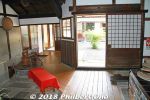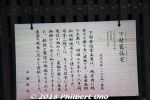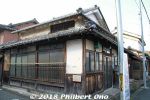 Image search results - "silk" Image search results - "silk" |

Oshima tsumugi is a local fabric woven from white silk and dyed. Oshima (Ooshima) Tsumugimura is a small textile factory where you can see how they weave and dye the tsumugi fabric. They also sell tsumugi fabrics as kimono, handkerchiefs, etc.
|
|

The factory is in a subtropical garden with tropical flowers and plants. Adult admission ¥500, open every day 9 a.m. to 5 p.m.Address: 1945 Akaogi Tatsugo Oshima, Kagoshima
Local buses stop at Oshima Tsumugimura bus stop. (From Amami Airport, 30 min. by bus.) http://www.tumugi.co.jp/
|
|

Tropical garden setting for this fabric factory. Oshima tsumugimura, Amami Oshima.
|
|

He is dyeing Oshima tsumugi silk fabric in mud.
|
|

He is dyeing Oshima tsumugi silk fabric in mud. The fabric color becomes black. Amami-Oshima island, Kagoshima.
|
|

Oshima (Ooshima) Tsumugimura
|
|

Tie-dyed (in mud) handkerchiefs. The fabric is also dyed with the sharinbai tree containing iron and tannin.
|
|
|

White hibiscus on Amami Oshima.
|
|
|
|

Oshima (Ooshima) Tsumugimura fabric factory.
|
|
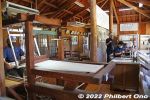
Inside the Oshima (Ooshima) Tsumugimura fabric factory. A few workers demonstrated the production of tsumugi silk fabric. This weaving step is called shimebata to make patterns on the silk.
|
|
|
|

Fabric dyes.
|
|

Oshima tsumugi fabric production steps.
|
|

Explanation of the Oshima tsumugi dyeing process.
|
|
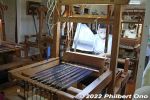
Loom
|
|

Loom to weave Oshima tsumugi.
|
|

Sample Oshima tsumugi fabric with in the typical black color.
|
|

Takakura storehouse with a steep thatched roof. Amami's traditional structure for storing grains. Oshima tsumugimura, Amami Oshima, Kagoshima. 奄美の高倉
|
|

Sago palms with a cone. Oshima Tsumugimura, Amami Oshima, Kagoshima. ソテツ
|
|

White hibiscus
|
|
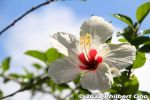
White hibiscus
|
|

Red hibiscus and other flowers in the tsumugi factory's garden setting. Amami Oshima, Kagoshima
|
|

Sago palms, Amami Oshima, Kagoshima
|
|
|

Oshima tsumugi handkerchief I bought for myself. Tie-dyed.
|
|

Visited a Tango chirimen company called Tayuh Textile Co., Ltd. (Tayuh Kigyo 田勇機業株式会社). http://www.tayuh.jp/
|
|

Tayuh Textile Co.'s chirimen textile factory in Kyotango.
|
|

Lobby of Tayuh Textile Co.
|
|

First we saw Tayuh Textile Co.'s gift shop and showroom.
|
|

Tayuh Kigyo's third-generation company president Tamoi Hayato (田茂井 勇人) first explained about their chirimen manufacturing process.These looping punch cards called "mon-gami" (紋紙) program the Jacquard loom to weave the design on the fabric. The holes in the punch cards tell the loom which threads are to be raised or not during the weaving process. These punch cards can be made by computer now.
|
|

He showed us the finished product, a chirimen fabric with a woven design.
|
|

This is 3,000 silk cocoons. That's how much silk is needed to make silk fabric for one kimono. One cocoon has 1200–1500 meters of silk thread. Since Japan produces very little silk, most are imported from China and Brazil. The Tango region consumes about one-third of Japan's raw silk imports. We were told the quality of silk from China and Brazil is very good.
|
|

Tayuh Kigyo's company motto: "A company that boasts quality has a future."
|
|

Tayuh Textile Co. makes almost everything, from the silk threads to the fabrics. We toured their impressive factory. These are spools of silk being made into threads.
|
|
|

This is a thread twister to twist the horizontal silk threads (weft) 3,000 to 4,000 times. This is a key step and how chirimen gets its crimped surface. After being woven into the fabric, the highly twisted weft threads try to untwist, creating the crimping.
|
|
|
|
|
|

Tayuh Kigyo's factory has 60 mechanized looms (50 of them are Jacquard looms).
|
|

Very noisy and very fast-moving. One employee monitors several looms.
|
|
|
|
|

Fascinating to watch.
|
|
|
|
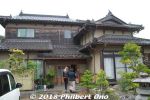
Tango chirimen silk fabric maker Tamiya Raden (民谷螺鈿).
|
|

Tamiya Raden (民谷螺鈿) had this stunning silk kimono on display for us. "Raden" means inlay (using shell, ivory, etc.). Typically, we think of lacquerware, but they do it on fabrics. This kimono took 2.5 years to make and is worth more than a Lamborghini or Rolls Royce.
|
|

Company president Tamiya Kyoji answered our many questions about this amazing kimono. His father Tamiya Katsuichiro took two years to develop and invent a method to inlay shell pieces in fabrics and showed their first example on a kimono obi sash in 1977.
|
|

The kimono was woven with pearly shell pieces from five species of oysters. Might be hard to see which parts of the kimono are the shell inlay, but the shiny parts are not the shell pieces. Very glittery.
|
|
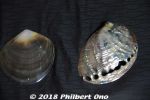
Pearly shells used in their fabrics.
|
|

First they attach the thin shell/pearly layers on a design on washi paper.
|
|

It's a painstaking, time-consuming process.
|
|

The completed design on washi paper is then sliced into "threads" that will be woven into the fabric.
|
|

Working on an obi sash.
|
|

Working on an obi sash.
|
|
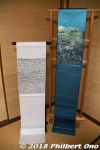
Tamiya Raden also makes kimono obi sashes.They also supply fabrics to world-famous luxury brands, but they can't brag about it because of a non-disclosure agreement.
|
|

This is a replica of an obi sash that was selected and worn by Empress Michiko recently for her birthday.The company is especially proud of this, but can't publicly brag about it. (The empress does not know who made the obi. She just liked the design.)
http://tamiya-raden.jp/
|
|

Another stop was a Tango chirimen wholesaler named Yoshimura Shouten (株式会社 吉村商店 峰山支店). Founded in 1830 and based in Kyoto city, this is their branch shop in in Mineyama, Kyotango.
|
|

They are in this distinctive, traditional building rebuilt in 1930 after the big 1927 Tango earthquake.
|
|
|

Inside Yoshimura Shouten. They have a small office space on the right, meeting room on the left, a fireproof kura storehouse in the back, and lots of floor space for textile merchandise.
|
|

Mineyama Branch Manager Yoshioka Hitoshi shows a PR poster of Bando Tamasaburo V posing with a Tango chirimen fabric in front of the shop's kura storehouse near where Yoshioka is standing.Tamasaburo V is one of the most famous and popular kabuki actors in Japan and Living National Treasure. He loves Tango chirimen fabrics and kabuki costumes also use Tango chirimen.
|
|

Inside their kura storehouse.
|
|

Yoshimura Shouten also creates its own designs like this "Hollywood chirimen" prototype with the the likeness of Audrey Hepburn, Charlie Chaplin, and Marilyn Monroe.
|
|

Chirimen fabric inspector uses a light box to carefully check for any defects and flaws in the material. Any defects in the material will reduce its value and the fabric (or kimono) will be sold for less.
|
|

Seal of approval on chirimen fabric.
|
|
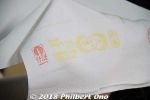
Seal of approval on chirimen fabric. Although Yoshimura Shouten is mainly a wholesaler, they also sell fabrics to individuals.http://yoshimura-shouten.jp/
|
|

He even waved goodbye to us!
|
|

Banner commemmorating the 300th anniversary of Tango chirimen in 2018.
|
|

Chirimen Kaido Road is a Tango chirimen manufacturing area in Kaya. Originally a castle town with Yasurajo Castle.Since it was a castle town (during the Sengoku Warring States Period), a few streets have sharp, narrow turns or corners to defend against any invading enemies. Some of the traditional homes were built in the 19th century or 1920s-30s. Part of the district escaped damage from the 1927 Tango earthquake.
|
|

Former Kaya Town Hall (旧加悦町役場庁舎) that was built in the 1930s.
|
|

Entrance to former Kaya Town Hall (旧加悦町役場庁舎) that was built in the 1930s. Currently closed.
|
|

One house had a small chirimen factory we could view through a window.
|
|

One house had a small chirimen factory we could view through a window.
|
|

There used to be four ryokan here, but this Izutsuya ryokan 井筒屋 is the only ryokan remaining in Chirimen Kaido.
|
|

Kimono displayed in Izutsuya ryokan.
|
|

Chirimen Kaido Road has a walking route to see the traditional buildings still remaining. That's a sake cellar on the left.
|
|
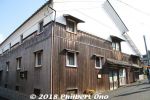
Sake cellar.
|
|

One home on the Chirimen Kaido Road the public can enter is the Former Bito Family Merchant's House (Kyu-Bitoke 旧尾藤家). The Bito family was a raw silk and chirimen wholesaler since the Edo Period. Very prominent and rich local family who also became active in local government and business during the Meiji Period.
http://www.yosano.or.jp/chirimen-kaido/?page_id=162
|
|

About the Former Bito Family Merchant's House (Kyu-Bitoke 旧尾藤家).
|
|

Inside the Former Bito Family Merchant's House (Kyu-Bitoke 旧尾藤家).
|
|
|

Houehold shrine inside Former Bito Family Merchant's House (Kyu-Bitoke 旧尾藤家).
|
|
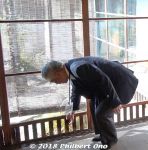
Before air conditioners, they had these sliding slats for ventilation in summer.
|
|

Kura storehouse and vault.
|
|

Western-style (Spanish) 2nd floor bedroom.
|
|

Western-style (Spanish) 2nd floor living room.
|
|

The Japanese-style first floor used very expensive materials. These thin wood pillars are shochikubai (matsu pine, bamboo, and ume plum tree).Former Bito family home, Yosano, Kyoto Prefecture.
|
|
|
|
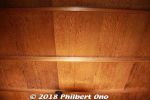
Ceiling wood is very rare, made of yaku-sugi cedar wood (屋久杉). Yaku-sugi is hundreds of years old, native to Yakushima island in Kagoshima Prefecture, and now illegal to cut down.
|
|

To Bathroom.
|
|

Bathroom sink
|
|

Bathroom
|
|

Inner courtyard
|
|

Palanquin
|
|
|

Exhibits in the kura storehouse.
|
|

Exhibits in the kura storehouse.
|
|

Old porcelain toilets.
|
|
|
|

Michael Jackson
|
|

The house was originally a farmhouse built and expanded during 1863 to 1930. Toward the left on the second floor is the Western-style (Spanish) part of the house built in 1928.
|
|

The first floor was Japanese style, while the second floor was Western-style (Spanish).Former Bito family home, Yosano, Kyoto Prefecture.
|
|

The first floor was Japanese style, while the second floor was Western-style (Spanish).
|
|
|
|

Kitchen
|
|

After the Bito Home, we continued our walking tour of Chirimen Kaido Road. Our guide, Aoki Jun'ichi, from Yosano Tourist Association, showed this exterior lattice design featuring the kanji character for "Tan" (from "Tango" 丹後) which is similar (by no coincidence in this case) to the kanji character for "yen" (円).
|
|
|
|
|
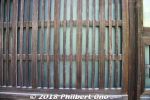
The windw lattice design indicated the family's occupation.
|
|
|
|
|
|

Temples were established here to defend against castle attackers.
|
|
|

Many of the Chirimen Kaido homes have explanatory signs, but you cannot enter them since they are private homes.
|
|
|
|

This home housed a chirimen factory and these windows let in light and air, but kept out prying eyes from passersby in the old days (when people were shorter I guess). Chirimen makers had secrets to keep.
|
|
|
|
|
|

Manhole for Kaya-cho, Yosano, Kyoto Prefecture.
|
|
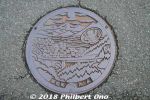
Manhole for Kaya-cho, Yosano, Kyoto Prefecture.
|
|
|
|
|























































































